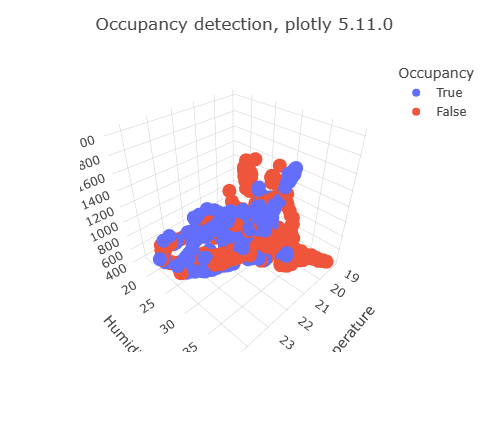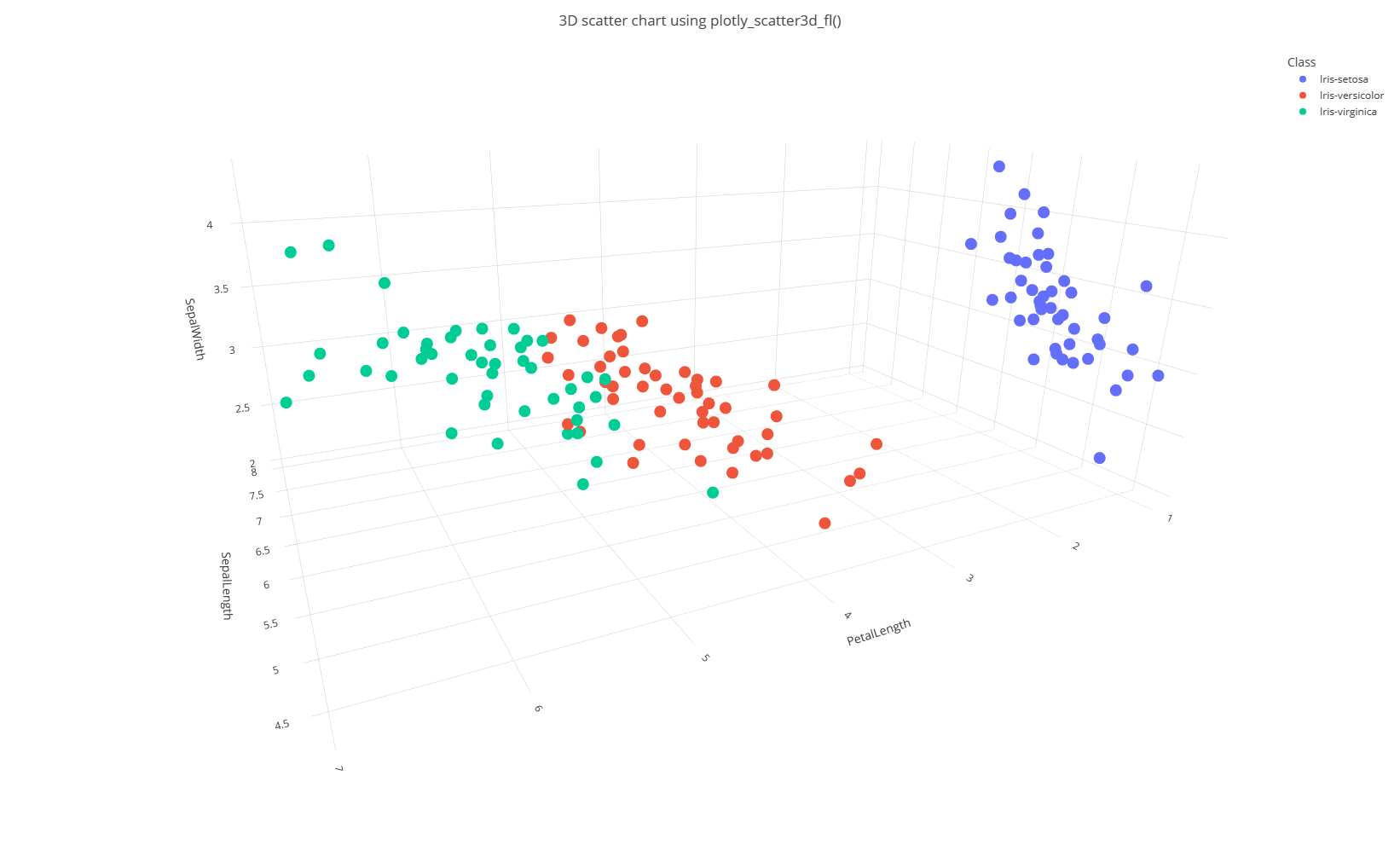Plotly visualization
The Plotly graphics library supports ~80 chart types that are useful for advanced charting including geographic, scientific, machine learning, 3d, animation, and many other chart types. For more information, see Plotly.
To render a Plotly visual in Kusto Query Language, the query must generate a table with a single string cell containing Plotly JSON. This Plotly JSON string can be generated by one of the following two methods:
Write your own Plotly visualization in Python
In this method, you dynamically create the Plotly JSON string in Python using the Plotly package. This process requires use of the python() plugin. The Python script is run on the existing nodes using the inline python() plugin. It generates a Plotly JSON that is rendered by the client application.
All types of Plotly visualizations are supported.
Example
The following query uses inline Python to create a 3D scatter chart:
OccupancyDetection
| project Temperature, Humidity, CO2, Occupancy
| where rand() < 0.1
| evaluate python(typeof(plotly:string),
```if 1:
import plotly.express as px
fig = px.scatter_3d(df, x='Temperature', y='Humidity', z='CO2', color='Occupancy')
fig.update_layout(title=dict(text="Occupancy detection, plotly 5.11.0"))
plotly_obj = fig.to_json()
result = pd.DataFrame(data = [plotly_obj], columns = ["plotly"])
```)

The Plotly graphics library supports ~80 chart types including basic charts, scientific, statistical, financial, maps, 3D, animations, and more. To render a Plotly visual in KQL, the query must generate a table with a single string cell containing Plotly JSON.
Since python isn’t available in this service, you create this Plotly JSON using a preprepared template.
Use a preprepared Plotly template
In this method, a preprepared Plotly JSON for specific visualization can be reused by replacing the data objects with the required data to be rendered. The templates can be stored in a standard table, and the data replacement logic can be packed in a stored function.
Currently, the supported templates are: plotly_anomaly_fl() and plotly_scatter3d_fl(). Refer to these documents for syntax and usage.
Example
let plotly_scatter3d_fl=(tbl:(*), x_col:string, y_col:string, z_col:string, aggr_col:string='', chart_title:string='3D Scatter chart')
{
let scatter3d_chart = toscalar(PlotlyTemplate | where name == "scatter3d" | project plotly);
let tbl_ex = tbl | extend _x = column_ifexists(x_col, 0.0), _y = column_ifexists(y_col, 0.0), _z = column_ifexists(z_col, 0.0), _aggr = column_ifexists(aggr_col, 'ALL');
tbl_ex
| serialize
| summarize _x=pack_array(make_list(_x)), _y=pack_array(make_list(_y)), _z=pack_array(make_list(_z)) by _aggr
| summarize _aggr=make_list(_aggr), _x=make_list(_x), _y=make_list(_y), _z=make_list(_z)
| extend plotly = scatter3d_chart
| extend plotly=replace_string(plotly, '$CLASS1$', tostring(_aggr[0]))
| extend plotly=replace_string(plotly, '$CLASS2$', tostring(_aggr[1]))
| extend plotly=replace_string(plotly, '$CLASS3$', tostring(_aggr[2]))
| extend plotly=replace_string(plotly, '$X_NAME$', x_col)
| extend plotly=replace_string(plotly, '$Y_NAME$', y_col)
| extend plotly=replace_string(plotly, '$Z_NAME$', z_col)
| extend plotly=replace_string(plotly, '$CLASS1_X$', tostring(_x[0]))
| extend plotly=replace_string(plotly, '$CLASS1_Y$', tostring(_y[0]))
| extend plotly=replace_string(plotly, '$CLASS1_Z$', tostring(_z[0]))
| extend plotly=replace_string(plotly, '$CLASS2_X$', tostring(_x[1]))
| extend plotly=replace_string(plotly, '$CLASS2_Y$', tostring(_y[1]))
| extend plotly=replace_string(plotly, '$CLASS2_Z$', tostring(_z[1]))
| extend plotly=replace_string(plotly, '$CLASS3_X$', tostring(_x[2]))
| extend plotly=replace_string(plotly, '$CLASS3_Y$', tostring(_y[2]))
| extend plotly=replace_string(plotly, '$CLASS3_Z$', tostring(_z[2]))
| extend plotly=replace_string(plotly, '$TITLE$', chart_title)
| project plotly
};
Iris
| invoke plotly_scatter3d_fl(x_col='SepalLength', y_col='PetalLength', z_col='SepalWidth', aggr_col='Class', chart_title='3D scatter chart using plotly_scatter3d_fl()')
| render plotly

Related content
Feedback
Was this page helpful?
Glad to hear it! Please tell us how we can improve.
Sorry to hear that. Please tell us how we can improve.